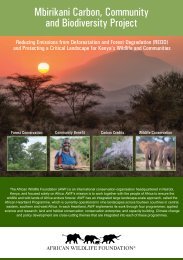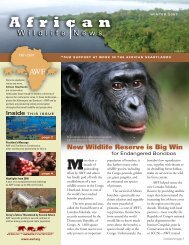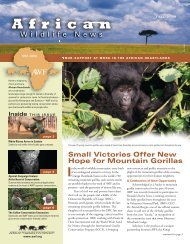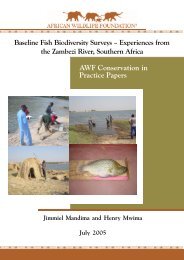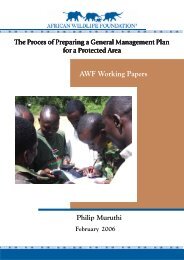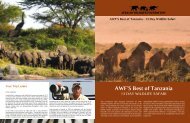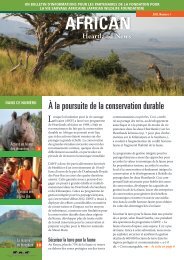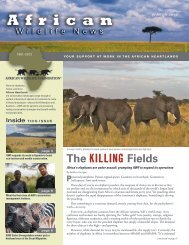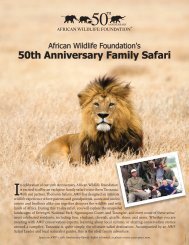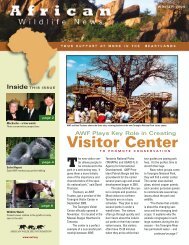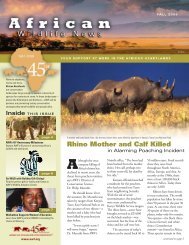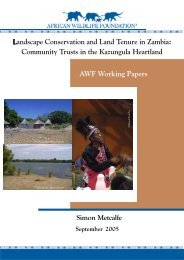Making a Difference? - African Wildlife Foundation
Making a Difference? - African Wildlife Foundation
Making a Difference? - African Wildlife Foundation
Create successful ePaper yourself
Turn your PDF publications into a flip-book with our unique Google optimized e-Paper software.
AWFworking withCommunitiesAWF’s Kadzo Kangwana interviews a Maasai villagerfor information on human-animal conflicts.Until the beginning of the twentieth century,communities and wildlife in Africa coexistedin a fairly harmonious manner. Althoughpeople used wildlife to sustain themselves,species were not seriously threatened. The human populationwas small, and land remained abundant.But in the late 19th century, wildlife began to disappearunder the more efficient and better-armed colonialhunters. Some animals were simply exterminated aspests. In response, hunting by local people was restrictedand strictly protected parks were established. Lawenforcement and preservation became the dominantapproaches to conservation.When AWF was founded 40 years ago, training parkwardens to manage these protected areas was a toppriority. As conservation thinking has evolved, AWF hasboth supported traditional approaches while taking thelead in implementing selected “new” approaches toconservation that attempt to rethink the relationshipbetween people and wildlife.What is now called “community conservation” isnot simply a matter of righting past wrongs, but recognizingthat virtually none of the parks of EastIn a program supported by AWF, the purebred herdof Ankole cattle protected in Lake Mburo Park,Uganda, has made the park more valuable tosurrounding communities.JANE W. GASTONPeter Lembuya is AWF’ssenior project officer,Heartlands and Species.AWFConservationist MarkStanley Price had workedfor AWF with oryx on theGalana Game Ranch projectbefore he becameAWF’s director of <strong>African</strong>operations in 1986.S. CROWLEY/AWFPatrick Bergin, who helped integrate community conservationAfrica, with the possible exception of Tsavo, is sufficientlylarge to include intact ecosystems. Vast numbersservices within Tanzania National Parks inthe early 1990s, is now AWF’s vice president forof wildlife—and certainly large predators and<strong>African</strong> operations. He is shown with Lucretia Taylor,director, USAID, Tanzania.herbivores—spend substantial time outside the strictconfines of parks.The bottom line? If Africa’s wildlife are to be maintainedin areas other than large fenced zoos, communitiesmust tolerate the presence of great numbers ofwild animals on their land.AWF Heartlands, along with its community conservationcomponent—which provides wildlife-friendly,non-fenced land as corridors between protectedareas—has become a fundamental strategy for maintainingmigrations and large populations into the22nd century. But developing the Heartlandsapproach has required time and aservice in TANAPA (Tanzania National Parks) by PatrickBergin (then freshly out of the Peace Corps, now vicepresident for <strong>African</strong> operations for AWF), the innovativework of Mark Infield at Lake Mburo Park in Uganda andthe creation of a community-run tourist facility adjacentto the Bwindi Impenetrable Forest, home to half theremaining mountain gorillas in the world.The Tanzania and Bwindi programs involved “benefitsharing”: Tourist revenues from the parks paid for communityprojects, such as village wells. But anotherapproach was required at Lake Mburo, a park reviled bythe Bahima pastoralists from whosespirit of innovation.grazing land it had been carved. AWFAWF HAS TAKENRethinking traditional conservationrecognized not just the economic valuebegan during the early 1960s in ZimbabweTHE LEAD IN of the pastoralists’ Ankole longhorn cat-with the work of Raymondtle—a rare breed comprising only 5 per-IMPLEMENTINGDasmann that eventually evolvedcent of Africa’s cattle—but also theirinto the pioneer CAMPFIRE (CommunalNEW APPROACHES cultural and spiritual significance. ByAreas Management Programmeprotecting a small, purebred herd ofTO CONSERVATION.for Indigenous Resources). InspiredAnkole, Lake Mburo would gain culturalby Dasmann’s efforts to “domesticate”wildlife as a less ecologically destructive alternativeto cattle, for a decade beginning in 1970 AWFsupported the Galana Game Ranch Research Projectin Kenya and its later spin-off, the Botswana GemsbokDomestication Project. In East Africa other earlyexperiments around Amboseli National Park were ledby Dyani Berger, David Sindiyo and David Western.AWF began directly working on community conservationin 1988 to test the viability of dialogue betweenpark authorities and pastoral communities aroundTsavo National Park in Kenya.Building on AWF’s pioneering work in Kenya, the “ProtectedAreas: Neighbors as Partners” program expandedto include development of a community conservationallies in its struggle to preserve theglobally important biodiversity within the park itself.Traditional law enforcement in protected areas isrelatively straightforward compared to the complexitiesof community conservation, which has been atrial-and-error process even for AWF. In Kenya, RichardLeakey introduced an innovative plan to share 25 percentof park revenues with surrounding communities.The program later failed, however, due to insufficientrevenue and relatively unsophisticated application.Now in its “second generation” of community conservation,AWF increasingly looks to partnershipsbetween private businesses such as ConsCorps andWilderness Safaris to generate benefits to communities(see “Partnerships with the Private Sector”). ❍AWFF ALL 200114



